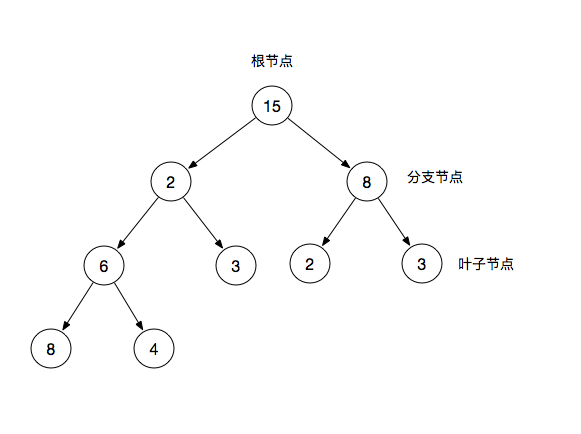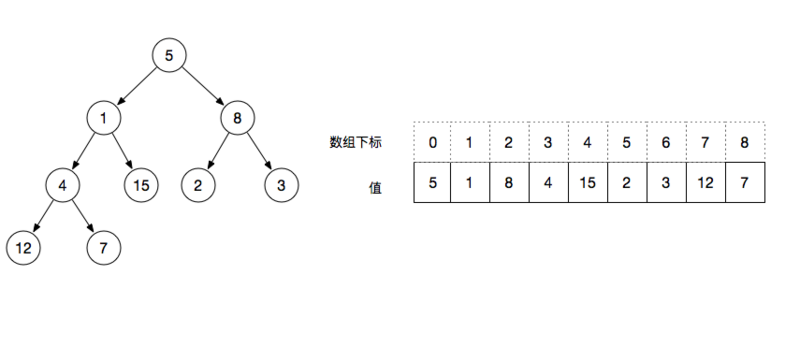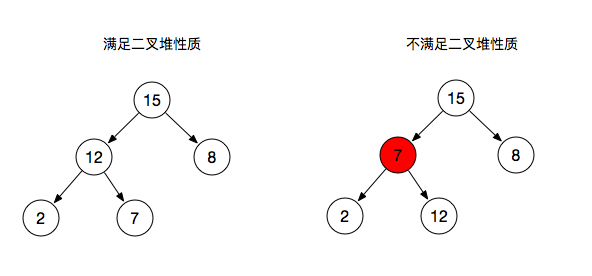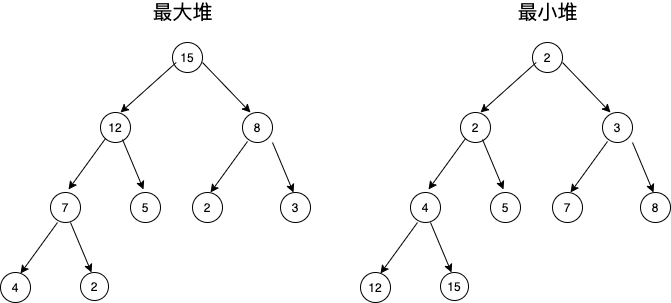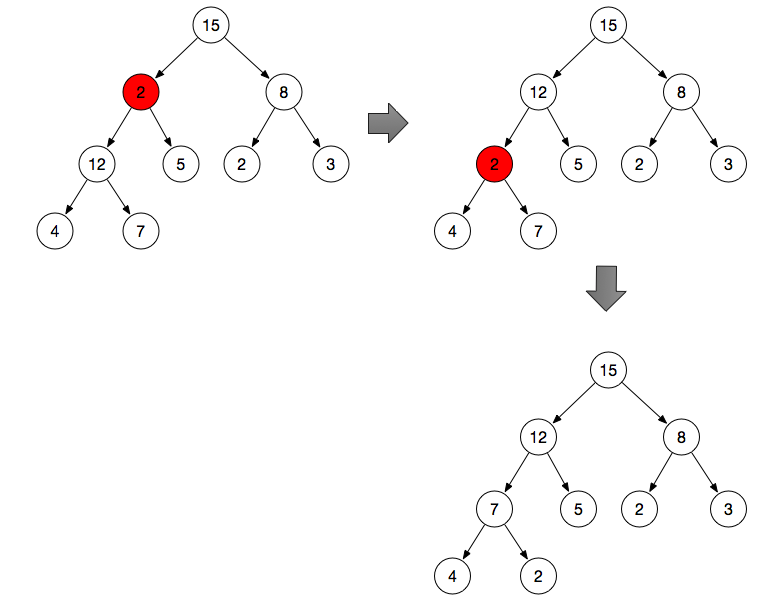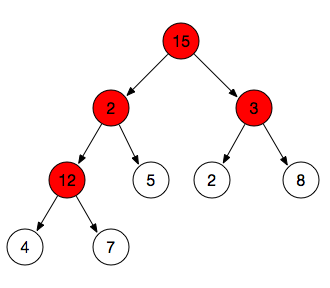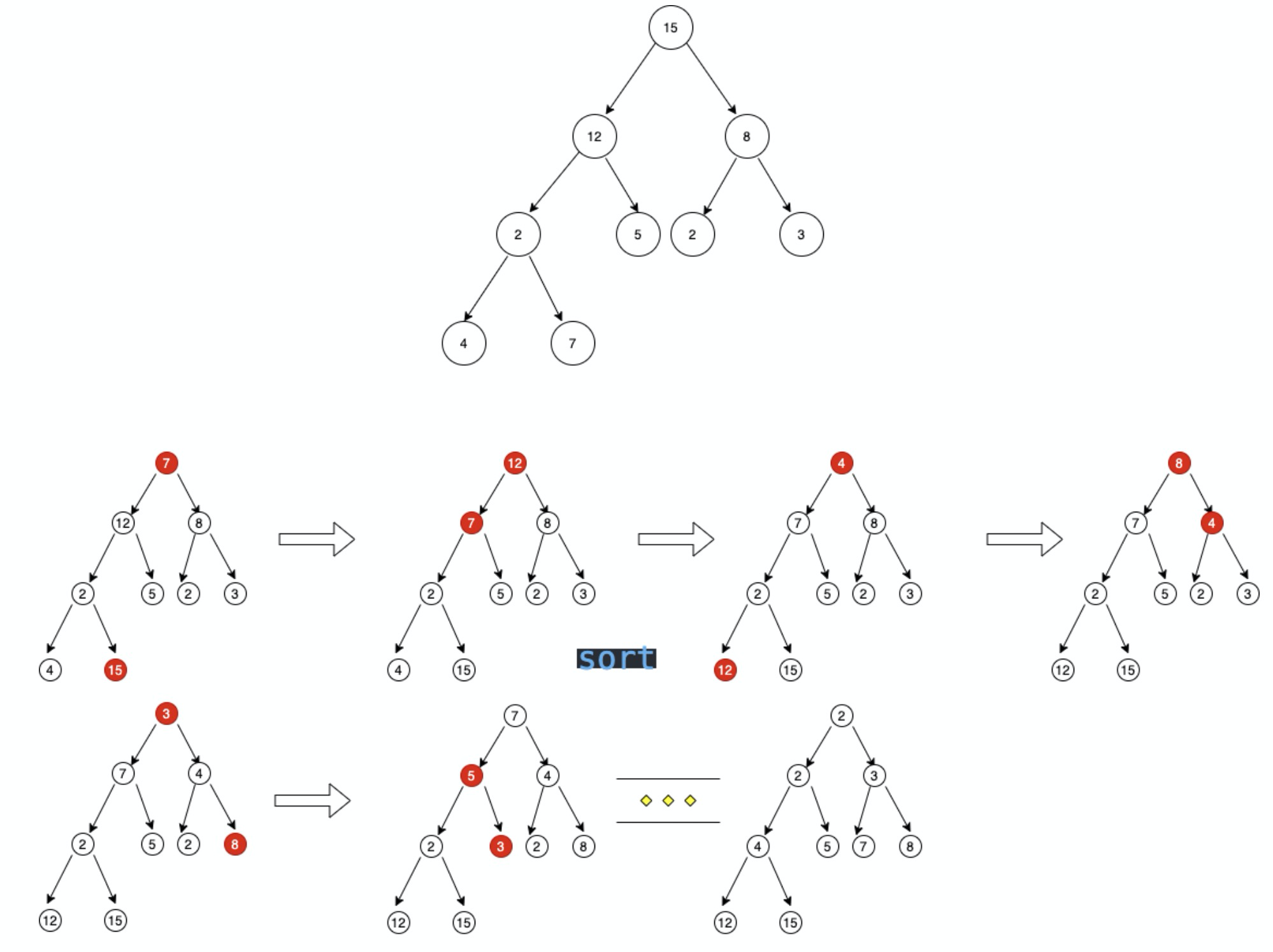如何用 JS 實現二叉堆
前言
二叉樹(Binary Tree)是一種樹形結構,它的特點是每個節點最多只有兩個分支節點,一棵二叉樹通常由根節點、分支節點、葉子節點組成,如下圖所示。每個分支節點也常常被稱作為一棵子樹,而二叉堆是一種特殊的樹,它屬于完全二叉樹。
二叉樹與二叉堆的關系
在日常工作中會遇到很多數組的操作,比如排序等。那么理解二叉堆的實現對以后的開發效率會有所提升,下面就簡單介紹一下什么是二叉樹,什么是二叉堆。
二叉樹特征
- 根節點:二叉樹最頂層的節點
- 分支節點:除了根節點以外且擁有葉子節點
- 葉子節點:除了自身,沒有其他子節點
在二叉樹中,我們常常還會用父節點和子節點來描述,比如上圖中左側節點 2 為 6 和 3 的父節點,反之 6 和 3 是 2 子節點。
二叉樹分類
二叉樹分為滿二叉樹(full binary tree)和完全二叉樹(complete binary tree)。
- 滿二叉樹:一棵深度為 k 且有 2 ^ k - 1個節點的二叉樹稱為滿二叉樹
- 完全二叉樹:完全二叉樹是指最后一層左邊是滿的,右邊可能滿也可能不滿,然后其余層都是滿的二叉樹稱為完全二叉樹(滿二叉樹也是一種完全二叉樹)
二叉樹結構
從圖中我們可以看出二叉樹是從上到下依次排列下來,可想而知可以用一個數組來表示二叉樹的結構,從下標 index( 0 - 8 ) 從上到下依次排列。
- 二叉樹左側節點表達式 index * 2 + 1。例如:以根節點為例求左側節點,根節點的下標為0,則左側節點的序數是1 ,對應數組中的值為1
- 二叉樹右側節點表達式 index * 2 + 2。例如:以根節點為例求右側節點,根節點的下標為0,則右側節點的序數是2 ,對應數組中的值為 8
- 二叉樹葉子節點表達式 序數 >= floor( N / 2 )都是葉子節點(N是數組的長度)。例如:floor( 9 / 2 ) = 4 ,則從下標 4 開始的值都為葉子節點
二叉堆特征
二叉堆是一個完全二叉樹,父節點與子節點要保持固定的序關系,并且每個節點的左子樹和右子樹都是一個二叉堆。
從上圖可以看出
- 圖一:每個父節點大于子節點或等于子節點,滿足二叉堆的性質
- 圖二:其中有一個父節點小于子節點則不滿足二叉堆性質
二叉堆分類
二叉堆根據排序不同,可以分為最大堆和最小堆
- 最大堆:根節點的鍵值是所有堆節點鍵值中最大者,且每個父節點的值都比子節點的值大
- 最小堆:根節點的鍵值是所有堆節點鍵值中最小者,且每個父節點的值都比子節點的值小
如何實現二叉堆
通過上面的講述想必大家對二叉堆有了一定的理解,那么接下來就是如何實現。以最大堆為例,首先要初始化數組然后通過交換位置形成最大堆。
初始化二叉堆
從上面描述,我們可以知道二叉堆其實就是一個數組,那么初始化就非常簡單了。
- class Heap{
- constructor(arr){
- this.data = [...arr];
- this.size = this.data.length;
- }
- }
父子節點交換位置
圖一中 2 作為父節點小于子節點,很顯然不符合最大堆性質。maxHeapify 函數可以把每個不符合最大堆性質的節點調換位置,從而滿足最大堆性質的數組。
調整步驟:
- 調整分支節點 2 的位置(不滿足最大堆性質)
- 獲取父節點 2 的左右節點 ( 12 , 5 ) ,從 ( 2 , 15 , 5 ) 中進行比較
- 找出最大的節點與父節點進行交換,如果該節點本身為最大節點則停止操作
- 重復 step2 的操作,從 2 , 4 , 7 中找出最大值與 2 做交換(遞歸)
- maxHeapify(i) {
- let max = i;
- if(i >= this.size){
- return;
- }
- // 當前序號的左節點
- const l = i * 2 + 1;
- // 當前需要的右節點
- const r = i * 2 + 2;
- // 求當前節點與其左右節點三者中的最大值
- if(l < this.size && this.data[l] > this.data[max]){
- max = l;
- }
- if(r < this.size && this.data[r] > this.data[max]){
- max = r;
- }
- // 最終max節點是其本身,則已經滿足最大堆性質,停止操作
- if(max === i) {
- return;
- }
- // 父節點與最大值節點做交換
- const t = this.data[i];
- this.data[i] = this.data[max];
- this.data[max] = t;
- // 遞歸向下繼續執行
- return this.maxHeapify(max);
- }
形成最大堆
我們可以看到,初始化是由一個數組組成,以下圖為例很顯然并不會滿足最大堆的性質,上述 maxHeapify 函數只是對某一個節點作出對調,無法對整個數組進行重構,所以我們要依次對數組進行遞歸重構。
- 找到所有分支節點 Math.floor( N / 2 )(不包括葉子節點)
- 將找到的子節點進行 maxHeapify 操作
- rebuildHeap(){
- // 葉子節點
- const L = Math.floor(this.size / 2);
- for(let i = L - 1; i >= 0; i--){
- this.maxHeapify(i);
- }
- }
生成一個升序的數組
- swap 函數交換首位位置
- 將最后一個從堆中拿出相當于 size - 1
- 執行 maxHeapify 函數進行根節點比較找出最大值進行交換
- 最終 data 會變成一個升序的數組
- sort() {
- for(let i = this.size - 1; i > 0; i--){
- swap(this.data, 0, i);
- this.size--;
- this.maxHeapify(0);
- }
- }
插入方法
Insert 函數作為插入節點函數,首先
- 往 data 結尾插入節點
- 因為節點追加,size + 1
- 因為一個父節點擁有 2 個子節點,我們可以根據這個性質通過 isHeap 函數獲取第一個葉子節點,可以通過第一個葉子節點獲取新插入的節點,然后進行 3 個值的對比,找出最大值,判斷插入的節點。如果跟父節點相同則不進行重構(相等滿足二叉堆性質),否則進行 rebuildHeap 重構堆
- isHeap() {
- const L = Math.floor(this.size / 2);
- for (let i = L - 1; i >= 0; i--) {
- const l = this.data[left(i)] || Number.MIN_SAFE_INTEGER;
- const r = this.data[right(i)] || Number.MIN_SAFE_INTEGER;
- const max = Math.max(this.data[i], l, r);
- if (max !== this.data[i]) {
- return false;
- }
- return true;
- }
- }
- insert(key) {
- this.data[this.size] = key;
- this.size++
- if (this.isHeap()) {
- return;
- }
- this.rebuildHeap();
- }
刪除方法
delete 函數作為刪除節點,首先
- 刪除傳入index的節點
- 因為節點刪除,size - 1
- 重復上面插入節點的操作
- delete(index) {
- if (index >= this.size) {
- return;
- }
- this.data.splice(index, 1);
- this.size--;
- if (this.isHeap()) {
- return;
- }
- this.rebuildHeap();
- }
完整代碼
- /**
- * 最大堆
- */
- function left(i) {
- return (i * 2) + 1;
- }
- function right(i) {
- return (i * 2) + 2;
- }
- function swap(A, i, j) {
- const t = A[i];
- A[i] = A[j];
- A[j] = t;
- }
- class Heap {
- constructor(arr) {
- this.data = [...arr];
- this.size = this.data.length;
- this.rebuildHeap = this.rebuildHeap.bind(this);
- this.isHeap = this.isHeap.bind(this);
- this.sort = this.sort.bind(this);
- this.insert = this.insert.bind(this);
- this.delete = this.delete.bind(this);
- this.maxHeapify = this.maxHeapify.bind(this);
- }
- /**
- * 重構堆,形成最大堆
- */
- rebuildHeap() {
- const L = Math.floor(this.size / 2);
- for (let i = L - 1; i >= 0; i--) {
- this.maxHeapify(i);
- }
- }
- isHeap() {
- const L = Math.floor(this.size / 2);
- for (let i = L - 1; i >= 0; i--) {
- const l = this.data[left(i)] || Number.MIN_SAFE_INTEGER;
- const r = this.data[right(i)] || Number.MIN_SAFE_INTEGER;
- const max = Math.max(this.data[i], l, r);
- if (max !== this.data[i]) {
- return false;
- }
- return true;
- }
- }
- sort() {
- for (let i = this.size - 1; i > 0; i--) {
- swap(this.data, 0, i);
- this.size--;
- this.maxHeapify(0);
- }
- }
- insert(key) {
- this.data[this.size++] = key;
- if (this.isHeap()) {
- return;
- }
- this.rebuildHeap();
- }
- delete(index) {
- if (index >= this.size) {
- return;
- }
- this.data.splice(index, 1);
- this.size--;
- if (this.isHeap()) {
- return;
- }
- this.rebuildHeap();
- }
- /**
- * 交換父子節點位置,符合最大堆特征
- * @param {*} i
- */
- maxHeapify(i) {
- let max = i;
- if (i >= this.size) {
- return;
- }
- // 求左右節點中較大的序號
- const l = left(i);
- const r = right(i);
- if (l < this.size && this.data[l] > this.data[max]) {
- max = l;
- }
- if (r < this.size && this.data[r] > this.data[max]) {
- max = r;
- }
- // 如果當前節點最大,已經是最大堆
- if (max === i) {
- return;
- }
- swap(this.data, i, max);
- // 遞歸向下繼續執行
- return this.maxHeapify(max);
- }
- }
- module.exports = Heap;
示例
相信通過上面的講述大家對最大堆的實現已經有了一定的理解,我們可以利用這個來進行排序。
- const arr = [15, 12, 8, 2, 5, 2, 3, 4, 7];
- const fun = new Heap(arr);
- fun.rebuildHeap(); // 形成最大堆的結構
- fun.sort();// 通過排序,生成一個升序的數組
- console.log(fun.data) // [2, 2, 3, 4, 5, 7, 8, 12, 15]
總結
文章中主要講述了二叉樹、二叉堆的概念,然后通過代碼實現二叉堆。我們可以通過二叉堆來做排序和優先級隊列等。














